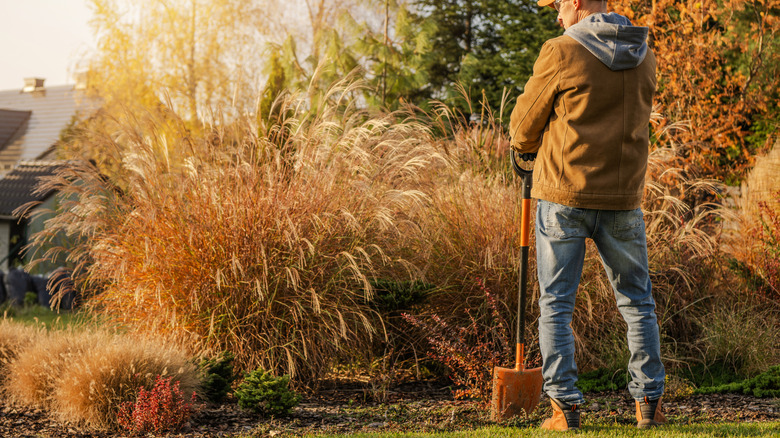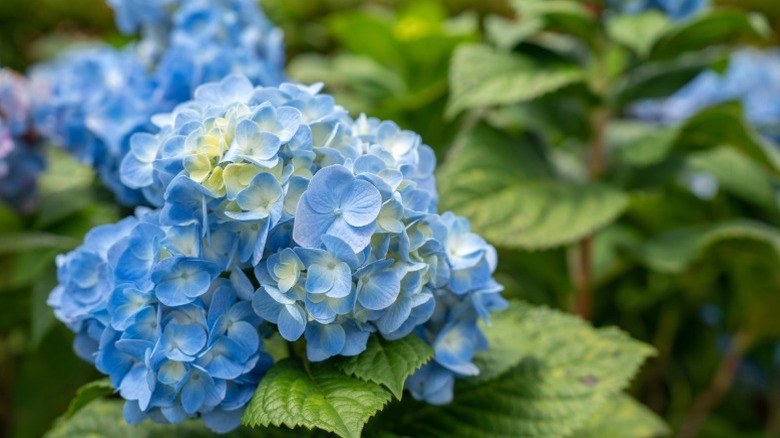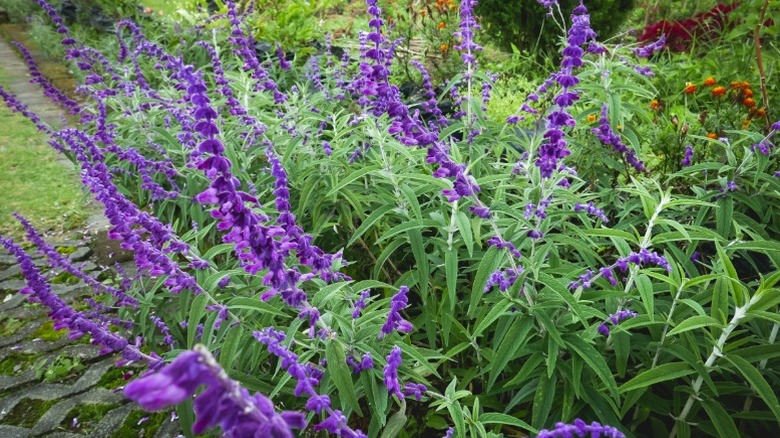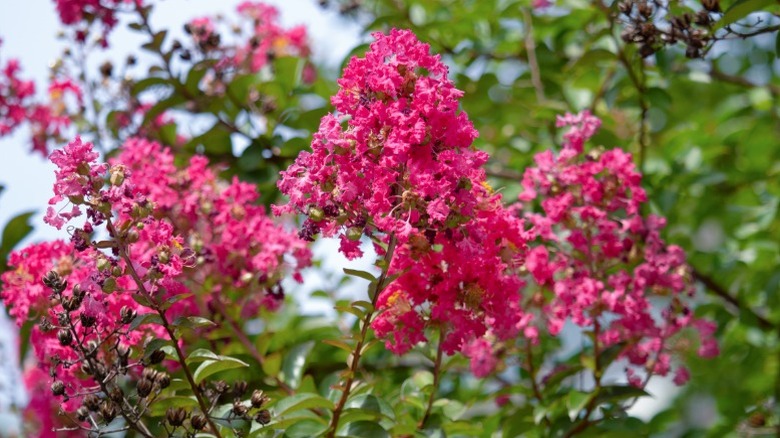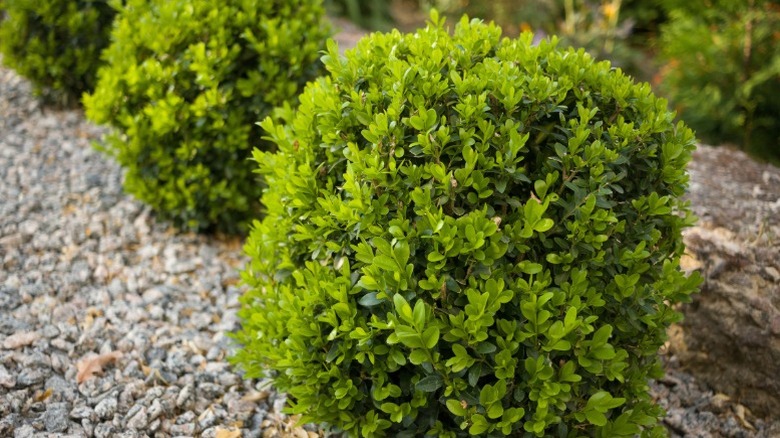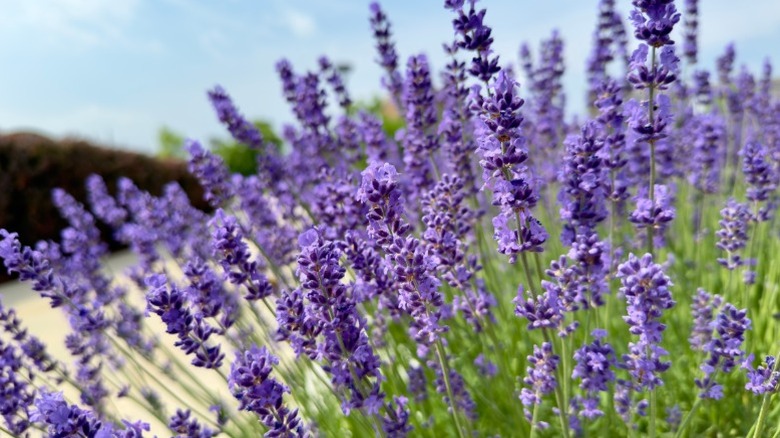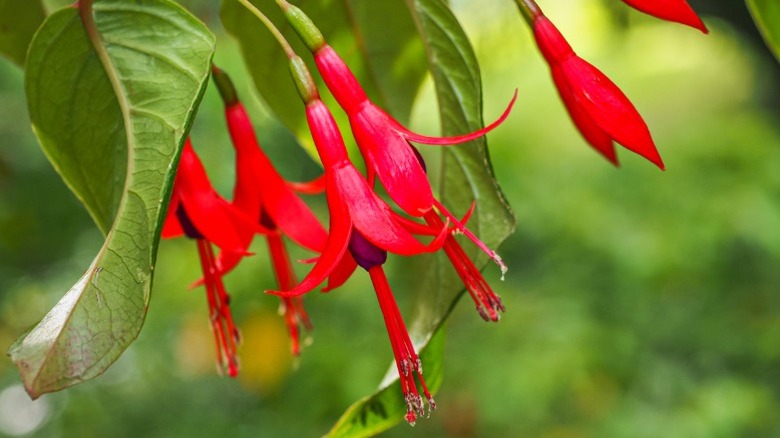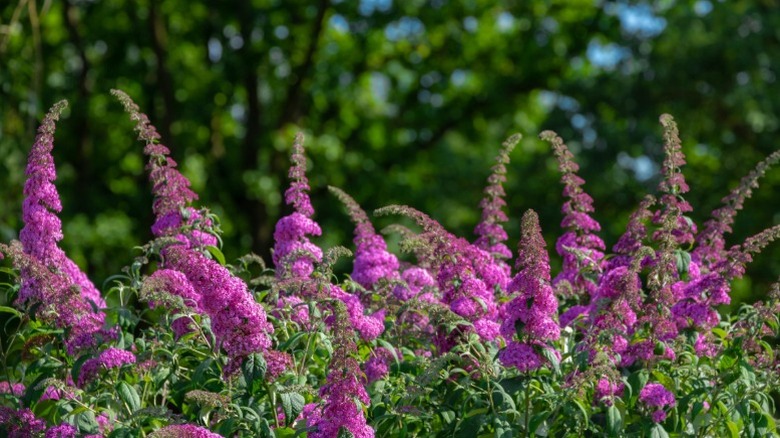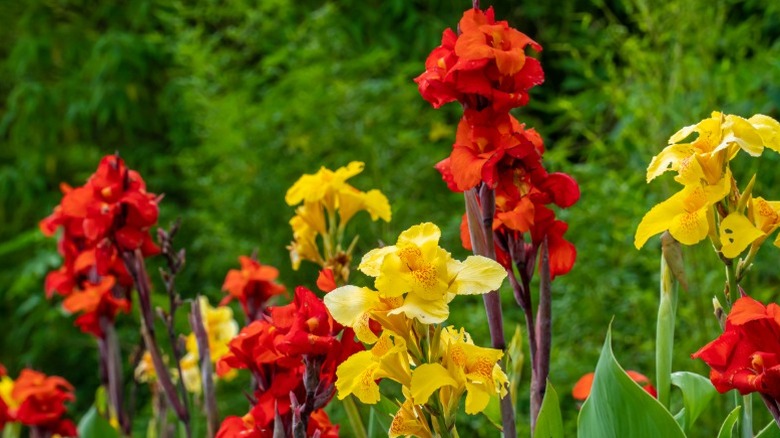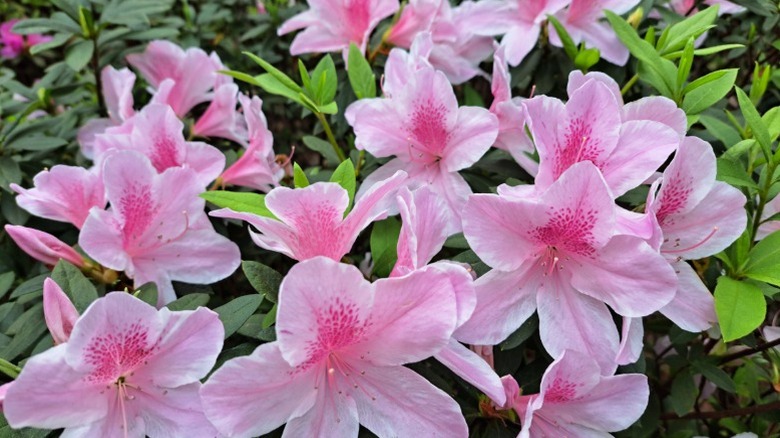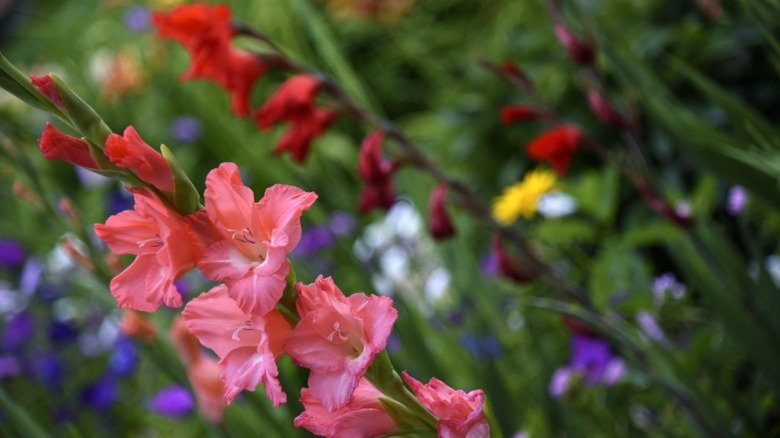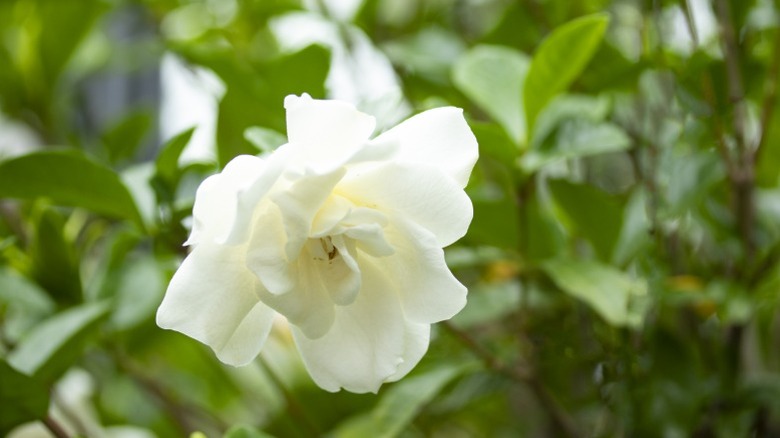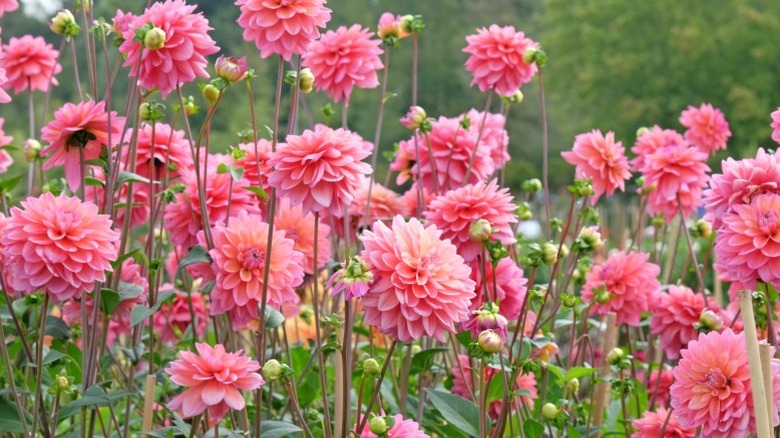12 Perennial Plants You Should Avoid Planting In The Fall
There are so many perennial plants that will bring timeless beauty to the garden for years, from gorgeous, heavily scented hyacinth to lush and colorful roses. Filling your yard with perennials, plants that return year after year, is an excellent way to create a garden that you can enjoy without the need to buy more seeds or plants. However, timing is key when establishing perennials. While fall is the right time to put many species in the ground due to consistently mild temperatures, it can be the worst time for some perennials due to increased stress over the cold winter. Mexican bush sage, English lavender, canna lilies, dahlias, and even seemingly tough plants like hardy fuchsia and boxwoods struggle with fall planting, among many others.
For instance, evergreens do not go dormant in the winter, which means they need more time to establish their roots before temperatures drop. Likewise, while some perennial bulbs grow best after a fall planting, others, like summer-flowering bulbs, require warm soil and no risk of frost to survive. Finally, always consider your USDA Hardiness Zone before planting any perennial in fall. In Zone 3, for example, the ground gets too cold too quickly for successful fall planting.
Bigleaf hydrangeas
Fall is typically an ideal time for planting all species of hydrangeas (Hydrangea spp.), including bigleaf hydrangea (Hydrangea macrophylla). However, it might be best to avoid planting them in the fall if cold stress and injury have you worried. Hardy in Zones 6 through 11, bigleaf hydrangeas produce their flowers on old growth from the year before. Cold injury to flower buds is common with bigleaf hydrangeas planted in the fall, and it can lead to fewer flowers. Bigleaf hydrangeas are more likely to experience issues due to freezes and shifting winter temperatures, so consider planting in the springtime once the weather warms up.
Mexican bush sage
A tall, showy perennial, Mexican bush sage (Salvia leucantha) attracts pollinators to your yard with its nectar-filled blooms. Typically blooming from summer into fall, this herbaceous perennial is only hardy in Zones 7 to 10. In cooler climates, like Illinois, gardeners only enjoy their blooms for a short time. Avoid planting these frost-sensitive salvia species in the fall because they cannot withstand harsh weather. Instead, this salvia should be started indoors and put outside in spring once the threat of frost has passed. The only gardeners who don't need to avoid fall planting live in Zones 10 and 11.
Common crape myrtle
A lovely Asian species popular in the U.S., the common crape myrtle (Lagerstroemia indica) features fantastic flowering in the summer with delicate petals in shades of pink, red, white, and purple. This species, often grown as a multi-trunked tree or shrub, is very cold-sensitive. It's recommended that it be grown in a protected spot to avoid damage from wind. If you choose to plant in the fall, the shrub might not establish itself well before cold weather hits. The result can be cold damage, especially in areas below Zone 7. Plant them in early spring to avoid stress.
Boxwoods
Similar to how boxwoods (Buxus spp.) are plants you shouldn't be pruning in the fall, you also should avoid planting them in the fall. Boxwoods, which comprise over 90 species, are broadleaf evergreens that can be susceptible to drought stress in the fall and winter. Cold hardiness varies, ranging from Zones 5 to 9, depending on the species. While you might be able to get by planting them in early fall, it can be tricky to ensure the temperatures do not get too cold before the boxwood's shallow roots are properly established. Dry winters can also invite disease amongst young boxwoods.
English lavender
English lavender (Lavandula angustifolia) is a beautiful, fragrant herb that adds visual interest to the garden, but also can be useful in teas and perfume. Despite its hardiness as a perennial herb, it is not easy or recommended to start growing lavender in the fall. You need to ensure at least two months of reliable, mild fall weather before putting a plant in the ground. If they do not have extensive, established roots, they may not live through the winter to flower again. Plus, root and stem growth in the fall can slow.
Hardy fuchsias
A perennial shrub, hardy fuchsia (Fuchsia magellanica) is an easy-to-grow option for anyone who loves attracting hummingbirds. This Central and South American perennial features lovely bell-shaped flowers and is typically hardy in Zones 5 to 10, unlike tender fuchsia species. Despite its hardiness, planting this perennial in the fall is not recommended. Instead, plant them in the summer to give them time to make themselves at home before winter. When planted in the fall, hardy fuchsia often does not survive the first cold snap.
Butterfly bush
A classic garden perennial with showy, pollinator-attracting flowers, butterfly bush (Buddleja davidii) is hardy in Zones 5 through 9. To avoid a shrub that fails to thrive, do not plant butterfly bushes in the fall. These plants prefer to have a longer period to grow and establish their root systems prior to cold weather. In fact, they can be pretty sensitive to the cold. Helping an established shrub survive the winter often requires a good layer of mulch. Butterfly bushes in general cannot tolerate wet soils, which often accompany winter. Plant in spring or summer to avoid these complications.
Canna lilies
Fantastic canna lilies (Canna x generalis) are unlike anything else, with their brightly-colored flowers and banana-shaped leaves. However, this is an example of a flowering perennial you should never plant in fall due to its sensitivity to cold and frosty weather. This tropical bulb loves the heat and is hardy in Zones 7 to 10. If you do not live in those areas, you should be pulling these bulbs out of the ground in the autumn. Avoid planting them in cool weather and wait until the soil has warmed sufficiently in the spring for summer blooms.
Rhododendrons
Rhododendrons (Rhododendron spp.) shrubs can live many years when properly maintained. Hardy in Zones 4 to 8, they still have sensitivity to cold and dry wind. Even if you find the ideal location to plant them away from harsh winds, they can still become damaged by rapid temperature changes. It is especially important to avoid planting rhododendrons in fall if you live in a colder climate to prevent a cold injury in newly planted rhododendrons. But for those in milder areas or those that experience very hot summers, rhododendron shrubs may experience less stress when planted in fall.
Gladiolus
Also known as sword lilies, charming gladiolus (Gladiolus spp.) flowers grow from tender bulbs. While you can grow them as true perennials in areas where they are hardy, from Zone 7 to 10, colder areas cannot. It's sometimes best to wait after the last frost in spring has come and gone to put these frost-sensitive flowers in the ground. By the time fall comes around, you should have been able to enjoy the blooms before digging up the bulbs to save for next year.
Gardenias
Native to China and Japan, high-maintenance gardenia (Gardenia jasminoides) shrubs are hardy in warmer parts of the U.S., from Zone 7 to 11. Gardenias are also broadleaf evergreens, which means they do not have the same tolerance of cold weather as conifers. While planting these perennials in the fall is generally safe or recommended in very mild climates, avoid this practice if you live anywhere with harsh winters. It is not uncommon for gardenias to be killed to the ground by bad frosts.
Dahlias
Dahlias (Dahlia spp.) are the cut flowers of your dreams, but you need to be smart when you choose to plant them. A summer-blooming bulb, dahlias do not have cold tolerance. There are ways to protect your dahlias from cold winter weather, but it's often easier to avoid planting them in the fall altogether. Over the fall and winter, their tuberous roots should be stored at temperatures between 35 and 50 degrees Fahrenheit. Hardy in Zones 7 to 10, planting them in spring a little before the last frost has passed will yield the best results for your cut flower garden.
